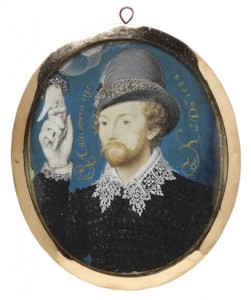
Today we have a guest article from author Melanie Tayor. Melanie is an art historian and novelist whose first novel, The Truth of the Line, is based on research she did into the life of miniaturist Nicholas Hilliard and images from the Ps of the Coram Rege rolls between 1553 and 1565.
The miniature portrait of an Unknown Young Man with the motto “Attici Amoris Ergo”, has fascinated me since childhood. Who is he, why the apparently gibberish motto and the date – 1588, coincidentally the same as the defeat of the Spanish Armada. The portrait was painted by Elizabeth I’s painter ‘in little’, Nicholas Hilliard.
Nicholas Hilliard was born in Exeter in or about the year 1547 and in 1555 he is sent to Europe with the Bodley family eventually ending up in Geneva with various other English Protestant exiles. The Bodley family returned to England in 1559 after the accession of Elizabeth I, but it is not known whether Hilliard returned to his family in Exeter or remained. First trained as a goldsmith in London, we do not know for certain who trained him in the art of painting in watercolour on vellum, but the most likely candidate is the woman artist, Levina Teerlinc, who was first recruited by Henry VIII.
Hilliard’s talent for portrait painting is more famous than his goldsmithing and he most probably designed and made the lockets for many of his portraits.
In 1572 Hilliard paints his first known miniature portrait of Elizabeth I. His ability for capturing his sitter’s likeness make him famous, and these miniature portraits are an ideal love token. Many carry hidden messages whose meanings are only known by the given, recipient and in some instances, the artist.
What do we know about the Unknown Young Man who clasps an unseen lady’s hand that comes from a cloud? Absolutely nothing except what we can take from the portrait itself. The young man appears to be in his twenties, has sandy hair and beard, is dressed in a jacket made of expensive black fabric with a white lace collar, wears a grey hat trimmed with a white feather and he holds a lady’s hand that comes from a cloud. The words Attici Amoris Ergo are written between him and the unknown woman’s hand as if to underline the connection between him, her and Atticus and on the other side are the words Anno Domini 1588, which indicates that the date is important, but unlike other portraits there is no indication of the age of the young man.
The pose is carefully constructed and our young man clasps a feminine hand whose lace on her cuffs is coloured black and white. Is the hand that of a married lover which is why she is hidden behind a cloud? If it is of his lover, why is she not responding to his touch as her fingers appear to rest inert within his? The only other clue to our sitter’s identity is the apparently incomprehensible motto, Attici Amoris Ergo, which translates literally as ‘Therefore by, with, from, through, or of the love of Atticus’.
During my researches into the life and work of Levina Teerlinc I researched the various Ps on the front sheet of the Coram Rege rolls which were the recording of the proceedings of the Queen’s Bench and always showed an image of the monarch as God’s purveyor of justice and mercy. For the Michaelmas Law term of 1560, the anonymous illuminator has taken the trouble to show the Queen’s expression. She appears concerned and perhaps worried. It appears the illuminator is portraying the state of mind of the monarch at this crisis. The Michaelmas Law term runs from October to December, which in 1560 is the term where the very monarchy is threatened by the scandal of Lady Dudley’s death and the international gossip regarding Elizabeth and Dudley’s scandalous behaviour.
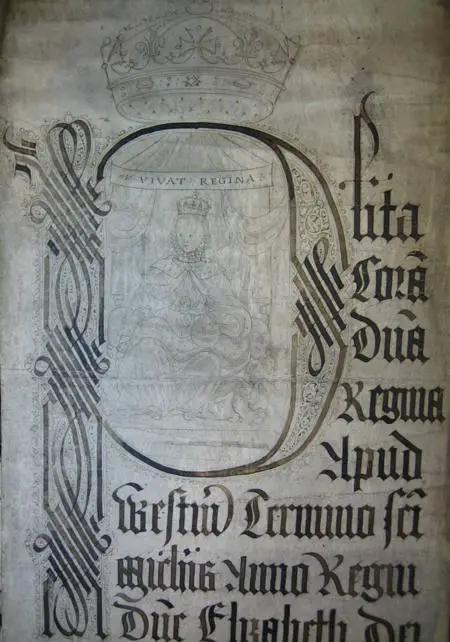
Over the centuries the debate about a possible royal bastard has continued and it seems unbelievable that the Queen of England might have hidden a pregnancy from the Court. During 1561 it was observed Elizabeth suffered from dropsy and swelled and was evidently unwell during this year. Elizabeth was recorded as suffering from all sorts of complaints which, for me, conflicts with other observations of her being a good and enthusiastic horsewoman who enjoyed the hunt as demonstrated in the woodcuts illustrating a book on hunting showing the queen being at a kill.
The next law term was the Hilary term starting in January 1561 and here Elizabeth’s image changes from what it had been since the beginning of her reign. No longer is she shown as the Virgin Queen with her hair flowing over her shoulders, but with her hair now hidden as if she were a married woman. Her expression is concerned, but no longer worried.
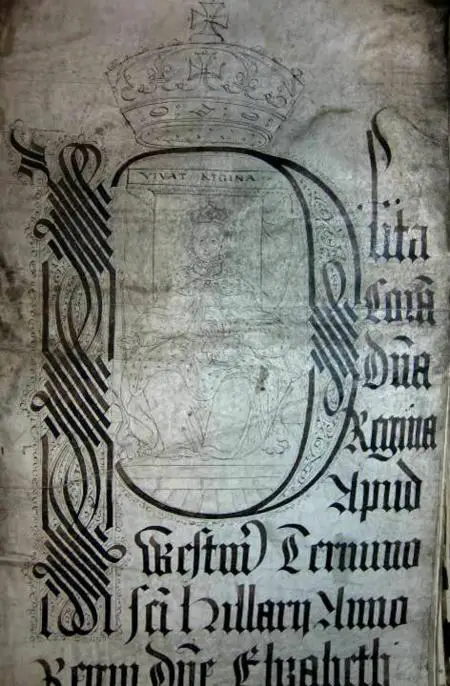
Why has her hair style changed to that of a married woman? If so, is it because the queen is pregnant as opposed to married?
If Elizabeth were pregnant, there is no better place to make such a statement. Perhaps it was even ordered that the event be recorded here. Lord Burghley would both have known about the Coram Rege Rolls and the image of the sovereign in these Ps, knowing that the content rather than the formulaic front sheet would be the main interest to those who consulted them, it is highly unlikely that these images would ever be looked at during Elizabeth’s reign.
There is precedence for this type of image change. A similar device is used in the Michaelmas term of 1554 when Mary I marries Philip II of Spain.
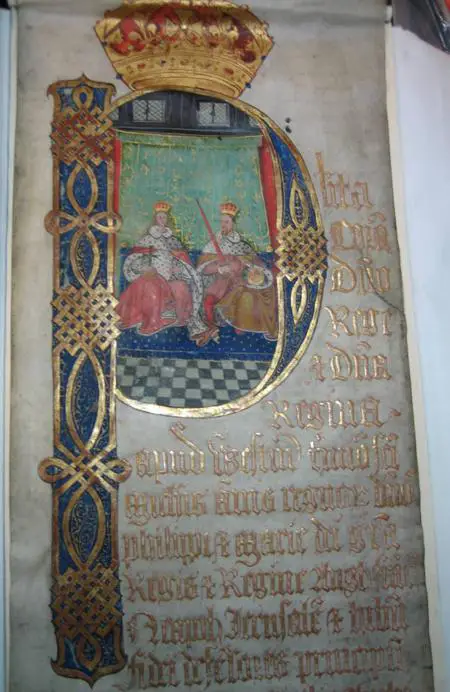
A virginal Mary sits on a throne next to her husband. In the next P for the Hilary Term of 1555 Mary is shown with her hair hidden under her familiar head-dress. In the November of 1554 Mary had announced she was pregnant.
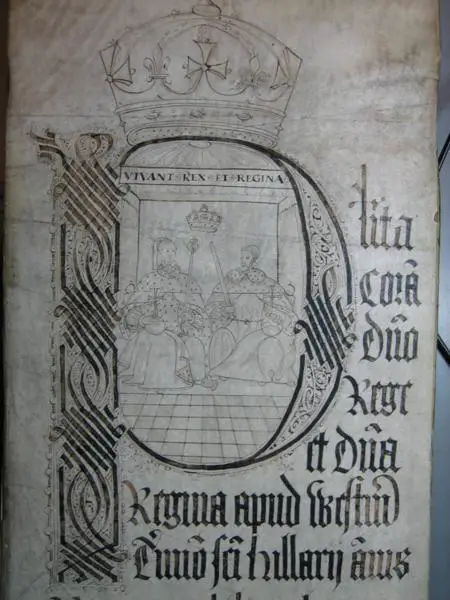
What better way to declare that the first English queen regnant is carrying an heir than to portray her as no longer a virgin by the way she wears her hair? There was no precedence as to how to show this, so perhaps the illuminator used the device of how a married woman was portrayed as a way of recording the forthcoming event. Since Elizabeth never married why change her image on the front of these documents and why portray specific expressions on her face?
Let us return to our portrait and the Latin motto – Attici Amoris Ergo. Why put apparent Latin gibberish on an expensive portrait miniature? Perhaps it was a code between the youth and his lady and by inclusion of the name, the code must therefore relate to the Roman citizen, Atticus. Perhaps the young man and the lady shared a friendship in a similar way to that between Cicero and Atticus as declared in Cicero’s famous writing on friendship? If so, why hide the woman’s identity and it still does not explain why their relationship is “therefore, by, with, from, through” or “of” this friendship.
Perhaps the meaning is metaphorical rather than a literal translation?
Atticus was a Roman citizen holding the rank of an equestrian knight. Here we might re-examine the meaning for another interpretation that this young man is through or a result of the love of a man who is of equestrian rank.
At this point we return to 1558 Elizabeth appointed Robert Dudley her Master of Horse. Is our young man making a statement of who his parents are in an arcane and subtle way?
What of the lady’s hand from the cloud? Is the black and white lace a clue as to her identity? Is the hidden woman his mother as opposed to a lover?
And what about the date of 1588? A young man calling himself Arthur Dudley was arrested in Santander after being shipwrecked on Spain’s northern Coast. It appears that Philip II believed his story and paid Arthur a stipend to remain at the Spanish Court; in effect, this Arthur was a prisoner. In the autumn of 1588 Walsingham is told by his spies in Madrid that this young man, Arthur, dies. For the full story of this evidence you need to read The Secret Life of Elizabeth I by Dr Doherty where he cites all his sources at the end of each chapter.
In early September 1588 we know that Elizabeth was celebrating the defeat of the Spanish Armada when she received the news that her beloved Dudley had died on his way to Buxton. We know that she locked herself in her room consumed with inconsolable grief until the door was forced. This is pure conjecture, but what if there had also been news from Spain that the young man calling himself Arthur Dudley was also dead? How could she have functioned having lost both her adored Robin and her child; a child the world did not know existed. A child who perhaps was supposed to rise from the ashes of her death, like a phoenix (another of Elizabeth’s emblems) and claim the English throne to become King Arthur, who, according to legend, will be England’s once and future king – Rex Quondam, Rex Futuris. It was a legend that was already linked with the Tudor dynasty and one that Elizabeth loved.
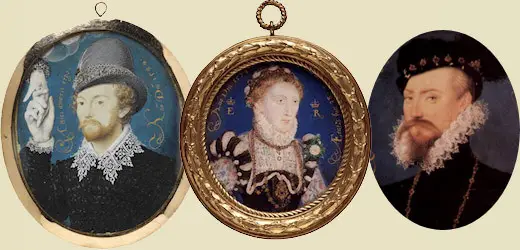
I only suggest an identity for Hilliard’s Unknown Young Man; you will have to examine these three portraits for family resemblances, study the evidence, consider my theory regarding the meaning behind the Latin motto and draw your own conclusions.
The Truth of the Line
Melanie is the author of The Truth of the Line, an historical novel, and you can read my review of it over on our book review site – click here.
You can read more about Melanie, her research and theories on her website http://www.thetruthoftheline.co.uk
Wow! What an amazing article. I read it twice and studied the pictures thoroughly as I read the second time. Very thought provoking!! Thanks for the guest article, Claire, and thanks Melanie for the brilliant work. I’m definitely going to explore your website and try to learn more about this!
What an interesting theory! I must say, Elizabeth’s image in the ‘P’s is very thought-provoking, as is the theory of Arthur being her son.
Regarding her hair being hidden, didn’t Elizabeth state she was married to England/her people/her realm? Perhaps this was the message she wanted to convey? Not married to a man, but married to England.
I cannot imagine she would have risked her life to give birth (especially since she didn’t want to marry). Surviving childbirth for any woman was risky, but as Queen, how could she put her life in jeopardy? Not to say she didn’t have some “fun”, ha, with Dudley, but to risk her life by getting pregnant?! Also, how could she have concealed being with child for nine months? Rumours would have to fly at court when the Queen stepped out in loose fitting garments for nine months and not the conventional corset.
Just a few thoughts 🙂
Thank you for this interesting post!
Thank you for this interesting article and the beautiful pictures! I’ve been interested in Robert Dudley and Elizabeth for many years and have my own little theory about who Arthur Dudley may have been. — I’d like to mention that according to some sources Arthur Dudley was alive and well in Spain for a number of years after 1588, living as Philip’s pensioner.
What’s your theory, Christine? Would love to hear more. Would you be interested in writing an article?
Claire, I’ve been planning to put an article together on this for years, so I hope one day …. Again thank you and Melanie for this great article, I will have to study it in more depth. I think the life of Arthur Dudley is a fascinating and very moving story, whoever he was exactly (I don’t think he was just another spy…).
Oh wow do you think its possible that after so many years and years it is known that Elizabeth had a baby ? The thought abt it is exciting and awstruck it makes you wonder that if a secret like that could be hidden what else don’t we know Wow the more you dig and dig the more it pays off nice article My congrats to the witter of the articles M.
What great reading, and a great theory.
Although it may seem highly improbable that Elizabeth could have kept a pregnancy hidden, it’s not impossible…claiming to have health issues that year, by keeping only her most trusted of ladies for dressing her. Kat Ashley, Blanche Parry, for two, the Countess of Warwick who was married to Robert Dudley’s brother, was she not a life long close friend and Lady-in-waiting to the Queen? have I got that righ? being sister-in-law to Elizabeth’s favourite/father of the child, close friend and confidant is a prime choice. She never had children of her own either, so would probably be emotionally understanding of the situation too.
Not all pregnancies are hughly noticable, small bumps.. look at all young girls that live at home, and parents don’t notice…those women who don’t know or look like they are pregnant, just think they have gained a little weight!! it happens. There could be many ways to disguise a pregnancy, even then, but…it’s the giving birth secretly that comes across as the biggest problem for me, but even that could be gotten around I suppose. It’s all very intriging and exciting too, the imagination could make many scenarios of this, sadly none would really have rock solid proof, though on the other hand there is no proof it didn’t happen either!, and as I have said ‘nothing’ is impossible, only highly improbable.
I love articles like this, seeing someone elses researched theories, and making you think ‘why not, or it could have’. Thanks Melanie
If Elizabeth had ever gotten pregnant, IMO, there would have been a quick marriage (to someone) so that the child could be born publicly and legitimately. I can’t imagine Elizabeth giving her successor (or her country) the same violence-causing problem that afflicted her own reign: doubts about the ruler’s legitimacy in the face of another with a clearly legitimate claim.
I’ve always wondered that. If indeed this is her son, why wouldn’t she share that with her country? Also, wouldnt the queen want him to be well cared for since she had little family to begin with? She seemed almost obsessed with any known kin. (However, she did
love her mother, but wore her in a ring ‘hidden’.) Thought provoking?
I merely toss a whole load of images into the public arena for discussion. Any pregnancy was fraught with problems and it was this year that Elizabeth was diagnosed with dropsy and swelled up. However, corsets and padding might have hidden the pregnancy with dropsy being given out as the reason for the swelling. We have to put ourselves in the medical mind of the 16th century.
These documents are so unlikely ever to have come to the public notice, it might be an artists ego that has decided that a royal pregnancy has to be document somewhere. If she, as she stated from the beginning of her reign, was married to her nation, then why wasn’t she portrayed with her hair hidden right from the beginning of her reign? Why change it in 1561? I have no idea, but it is interesting.
As to marriage if she were pregnant – Oh that would have been a disaster. Dudley was tainted with the unnatural death of his late wife. If she had married, she would have been subordinate to her husband and who was a likely candidate that could be married in a hurry? Plus, she had been incredibly vocal regarding marriage and remaining a Virgin!
Elizabeth was a complex and amazing woman and it is unlikely that we will ever know the truth, but she rewarded loyalty and had a fondness for Hilliard which I find intriguing. There are two versions of this Attici image and I believe that one belonged to the Earl of Warwick – Dudley’s brother …. more food for thought.
I had read from a document in a article that she took a mysterious leave for about 8 months, because she wasn’t feeling good, to get away for rest and it was about this time period. And the Southerns came into the scene to take the baby and raise it as their own. While Arthur lived in Spain under the graces of Phillip, he didn’t die ,he lived and fell in love with a Spainard and had a child. So his bloodline lived on. I wish I could remember more on the article. There is more but I can’t say.
I don’t think Elizabeth would have been subordinate to her husband as a matter of course. A case in point is Mary Stuart, Queen of Scots. She certainly was not subordinate to her second husband, Henry, Lord Darnley, and refused to grant him the crown matrimonial. Mary was Queen Regnant and remained so after their marriage. Is there any truth in Elizabeth’s alleged statement when she was told of Mary’s son’s birth (1566), “The Queen of Scots is lighter of a son, and I am but barren stock” ? There appears to be possible difficulty with pregnancy/birth in the Tudor dynasty at some point (none of Henry VIII ‘s children had children), and if Arthur Dudley was not Elizabeth’s son, could she have known that she could not conceive or bear children, as one possible reason (among others) for her not marrying? Just wondering…..
Could all this badinage by Elizabeth not be PR to deflect attention from the gossip about her scandalous behaviour with Dudley at the beginning of her reign? Mary I negotiated long and hard to ensure Philip had no jurisdiction in England, but this was an arranged marriage. Elizabeth realised that being a woman, it was best to tread the stage of monarchy alone. If it had been known that she was pregnant and unmarried, this would have brought her down and no-one, not even William Cecil, could have saved her reputation, or possibly even her life.
With miniatures, and especially this one, whilst there is a great deal of family likeness and all the portraits are seen by the same eye; plus the various images within the Ps of the Coram Rege Rolls suggesting that the queen might be up to something, it was, and is, all speculation.
What I find interesting is that this young man commissioned Hilliard to paint his portrait with an intriguing motto. Whatever the truth of the matter, it is unlikely we will EVER know. Hilliard’s key asset (other than natural talent) for his place as society’s most desired miniaturist was discretion, so he was not going to tell the truth, even if he knew. His sitter may not have told him his real name and given him the motto to include in the image as opposed to Hilliard thinking it up. I found it sufficiently intriguing to weave him into Hilliard’s story of his relationship with Elizabeth and the her Court, and despite all the information in the public domain, I’m still none the wiser.
What the discussion does show is how sympathetic we all are to Elizabeth because, officially, she never married or had children. However, she did love Dudley, but chose to put her duty to the country first, recognising that the people wanted peace and prosperity.
If she had found that she was pregnant in 1561, today we have little idea of what it would have been like to find yourself pregnant and unmarried AND Queen of England. Look how Katharine and Anne suffered when they miscarried? Not only having to go through the emotions and possible depression caused by these miscarriages, both were victims of male ego and ambition. We are very lucky to live in a much more forgiving society for us mere mortals.
First, a greatly fascinating article. The Spanish certainly believed the young man who claimed to be Arthur Dudley, the son of Elizabeth and Robert Dudley after an affair, was who he claimed to be. But then they would have reason to; he could be used as a useful propaganda weapon. Or he could have been exactly who he claimed to be. Look at those wide hooped skirts that the Queen wore; it may be possible to hide a baby under there, I guess, but on the other hand nothing that the Queen did in the bedroom was secret. Her movements were measured for health reasons, her sheets were examined every day and her monthly cycle was monitored and reported to William Cecil every day. The women around her may have been sworn to keep private what they learned in the chambers but they could also be gossips. Rumours would have escaped the bedchamber and Elizabeth would have had to take drastic measures to hush up her being pregnant.
Having her head covered showed that she was a married woman, but if hiding her hair meant she was with child; then is not Elizabeth giving the game away?
I have never accepted that Elizabeth I was the Virgin Queen in the sense of her sexual behaviour; she made herself into the Virgin Queen to replace the lost adoration of the Virgin Mary; and she had white make-up to hide her scares from smallpoz, which Elizabeth survived, but which left her scared. I believe that she was a passionate woman who loved to express herself freely and that she had a love affair with Robert Dudley and that love affair was public knowledge. I also believe she had sexual relations with other members of her court, at least until she became unattractive. She chose not to marry for personal reason, putting England at risk from several claims to the throne; but she also tried to balance alliances carefully. A child would have risked all of this; which is why I am not convinced that she had a child; but do not dismiss it as someway the secret could have been arranged.
I have not read your book as yet, but have read a couple of others and have seen the documentary that mentions the case of Arthur Dudley. What strikes me as odd however, is why did the Spanish not make more of this man’s claim against Elizabeth? I know he could never have sat on the throne but he would have discredited her claim to be the Virgin Queen.
If there is any amount of truth to this, my heart aches for the three of them.
It is Francis Bacon who was born in 1561 on 1/22. Look up parentage at Sirbacon.org/
Much evidence has been collected there. A lady named von Kunow wrote a book. People who gossiped were killed. Francis Bacon’s birth (baptismal?) certificate which says ‘Mr.” because he was a special baby. Comments by Anne Bacon that sound more like he was a ward than her own child, Nicholas Bacon not leaving him anything in his will. The special closeness Francis Bacon had with the Queen, but she could never acknowledge him as her son, nor could Dudley. If it is true, it is just so sad. And then, was Essex her second son? I don’t know enough about Arthur Dudley to say.
What if: the man were Francis Bacon, born 1561, and he was holding his mother the Queen’s hand? These miniatures were supposed to be obscure and personal, according to Camden, a contemporary scholar. “Attici amoris ergo,” and in the year of Dudley’s death.
There were two famous Romans named Atticus, Herodes Atticus and Titus Pomponius Atticus. Herodes Atticus Theatre was built by that Atticus to memorialize his wife’s recent death (note aptness). The Latin is “Therefore, or on account of, (ergo taking the genitive in that sense) the love of theatres (a genitive plural)(or, could also mean Amor personified, Dudley, who loved the theatre, as did the Queen). Or, it could have the sense of a dedication, “to or for the theatre (singular, dative–“of” strictly only in the plural).
The Palladium is another theatre named after its builder/architect, Palladio.
The first Atticus is a clue to the second Atticus. The Queen was a learned, classical scholar who addressed Parliament in Latin and studied the classics a lot. She would have known her Cicero. Francis Bacon incorporated references to Cicero into his own writing more than he did for any other classical writer.
It was Cicero’s Letters to the other Atticus, Titus Pomponious, being found by Petrarch in 1345 that began the Italian Renaissance. The English Renaissance was slower in coming; England was behind in terms of culture, manners, scholarship, modernity.
“Therefore, what?” A promise, secret pact between the Queen and Francis Bacon that she would protect him and dedicate herself to helping him build Elizabethan drama, language, learning to rival that on the Continent? Using it as a tool for the betterment of mankind? That he would not seek his birthright but urge her to promote Essex in his stead might also be part of it.
Just for the heck of it, I did a word search in the Letters to Atticus for “amore” and “ergo”. In the first book, letter 17 I found both, used twice close together. If Bacon were directing the Queen to that letter, surely he would not expect her to search the documents past Book I, without a computer search function! But there may be more. Somehow, there always seems to be more, another layer, with Shakespeare/Bacon. Maybe he was like Dalton Trumbo, editing and revising the scripts of others as well as doing his own writing, when he was blacklisted during the McCarthy era (Movie “Trumbo.”)
Looking at all the details, is his hat light purple instead of gray? Only royalty were allowed to wear purple. The Queen’s “colors” were black and white; “her” men in the tilts wore black and white. Maybe the lace he is wearing can be matched to lace in a different portrait. Does the trim on his hat match the trim on her dress? Looks like it might. Very interesting is the computer work done by Lillian F. Schwartz where the faces in the Droeshout portrait and Queen Elizabeth match. http://lillian.com/art-analysis/
Claire Asquith in “Shadowplay” wrote that Shakespeare was the only known playwright of the time who was never in trouble with the authorities. He must have been protected by powerful people. It is fascinating to explore these questions.
Did you know the Folger Shakespeare Library has a collection of images of Francis Bacon, including a drawing of a bust done of him at age 8? I don’t think most little kids had a bust made of them at age 8. Look at the size of his brain.http://picturingshakespeare.folger.edu/cdm/search/collection/p252501coll1/searchterm/francis
It seems likely someone must surely have figured out this interpretation of the motto before. Perhaps I saw it once and it was in the recesses of memory, about Atticus referring to the theatre. Anything is possible. I realize on an article promoting a book about Arthur Dudley, this interpretation may not be well received. Still, people who appreciate the search for truth know to keep an open mind. Thank you if you print this.
To correct something I wrote: I would translate, “On account of the love for the theatre. Attici is 2d decl. dative singular or nom. plural. (Not gen. pl–sorry.) That is in Latin. There were 2 Attici. Atticus was a Greek, but Cicero wrote in Latin to Atticus, except he sometimes would use a Greek form of a word on purpose.
The Romans said, the Greek cloak bows to the Roman toga and expected the Greeks to speak and write in Latin to them, but these two were friends. Only in the letters to Atticus would Cicero sometimes use Greek forms of some words. He had a large library which he shared with Cicero.
The Wikipedia article on Herodes Atticus tells us in Greek his name would have been Attikos and that he had a long string of names ending in Atticus Herodes. Lucius Vibullius Hipparchus Tiberius Claudis Atticus Herodes was his full name in Latin. It is fun to read the letters. I liked the Winstedt translation. Cicero opens his heart to his friend Atticus, but of course, it is not the Herodes but the other Atticus that Cicero writes to.
My Latin is so rusty–sorry. Attici is not dative (to or for) but 2d declension gen. singular (of) or nom. plural, making it easier. Theatres for the sake of love (or a special Love) or on account of the love of theatre. If you buy Attici as theatres. Thank you.
The Queen owned a copy of Cicero. She used to translate classical works as a pastime. Here, it was sold in auction.
http://www.invaluable.com/auction-lot/elizabeth-i,-queen-of-england.-cicero,-marcus-tu-53-c-5da482eb94
I have written a paper which touches on some of the themes explored on this page. The article, on Francis Bacon in The Merchant of Venice, is called “Bacon is Bellario with Just Desserts for All! An exploration of Mark Edwin Andrews’ Second Argument in his book, Law v. Equity in The Merchant of Venice, a Legalization of Act IV, Scene 1 (University of Colorado: Boulder 1965). It can be found at SirBacon.org. Click on “What’s new at the site?” copyright Christina G. Waldman 7/26/2016. There may be some readers in this discussion who are interested in reading it.
Well, I am a little embarrassed that I posted so many times here in 2016, but I just would like to mention that this paper I wrote on Francis Bacon turned into a book, Francis Bacon’s Hidden Hand in Shakespeare’s Merchant of Venice: A Study in Law, Rhetoric, and Authorship (New York: Algora Publishing, 2018).https://www.algora.com/545/book/details.html. I still am intrigued by this miniature. It is one of those fascinating mysteries of history.
the unknown man is anthony jenkinson https://en.wikipedia.org/wiki/Anthony_Jenkinson ….
I know that Find A Grave use it on their website as him (it was just added by another user) but it is not known who the sitter actually is. When it sold at Christies a few years ago, it was in a frame with “the cartouche engraved ‘R. Devereux Earl of Essex'”. I’m not sure how old the frame is.
I could not help but notice that the gloved hand shows a woman with long fingers as Elizabeth I was known to have. The year of the painting also lines up with the same year that the Spanish, who he was found to have gone to for ‘help’, lost their effort to overthrow Elizabeth. If this was his child could this be some type of indication he was trying to give to her that he was on her side? A plea for forgiveness? There have been others that have commented on the hands seemingly non responsive to his holding them and perhaps that is what his portrait is conveying that he has been loyal despite not being acknowledged or around. Combined with the death of her possible ‘former lover’ could this be a son reaching out to console a mother he never knew? It does state 1588, however, does it mean it was painted then or just in memory of that date? Just some thoughts to consider.
Hi,
I came about this because I did a special session with guides, sth I had never done before and it revealed to me a personal relationship to this Queen and not only the existence of a bastard child but actually his death. I saw a dark dome-like room with an intricately ornate tomb right in the middle raised high to the heart of the room, and some light commjng from above onto it. I felt an extreme, secret sorrow. I recognised this was the Virgin Queen grieving.
I wonder wether there is such a toombe in this Kingdom. The room is private, like a small chapel, and very dark. No windows. Only an opening at the top of this dome-like soace allows light in, a dim gothic-like ligt or scenne. I held this vision for a considerable amount of time, and have no doubts about my oerception. This was this morning. I have meanwhile looked online for any such child and have come accros several theories but have not seen evidence of her outliving the child. In my vision the son was a goung man still when he died. And I felt an immense maternal love mpurning over this tombe. The word that came to my mind as I perceived the intricate decor was ‘ filigree’ and the decor did not feel like stone but metal in my pereption. Almost like lace, like a mother’s delicate love itself, as in the lace in babies…i sense a poet though. Poetry.
I wonder if this in any way helps this study.
I oerceived a bit more but will leave only what I feel coukd be if help in any investigation in this realm. Please fell free to contact me.
A book by Paul Streitz asserts that QEI had at least 6 children, including Edward deVere 17th Earl of Oxford believed by many to have written the Shakespeare canon, Robert Devereaux 2nd Earl of Essex who fomented the Essex rebellion and was executed for it, Robert Cecil raised as the son of William Cecil Lord Burghley QEI’s most trusted councillor and mimed as Polonius in Hamlet, and Henry Wriothseley Earl of Southampton whose father was Oxford (The Prince Tudor theory!!!). Arthur Dudley was not among these sons, so that raises the possibility that QE I had at least 5 sons. Two daughters were mentioned by Streitz, and Arthur Dudley stated that he grew up among a number of children in a village before being taken to London. Arthur was the name of Henry VIII’s elder brother. Rumors had it that QEI made a “progress” through the countryside nearly every year of her 44-year reign, ostensibly to meet her subjects but really to deliver a new child out of the sight of uncontrolled eyes and arrange a home for the infant. Call me a conspirator, but we are starting with 5 sons and 2 daughters who we can name, plus an unknown number of other children who were probably mostly half-royal daughters that will never be named. Elizabethans well knew the extent of the irony behind the phrase “the virgin queen”.
In response to Katia, I have known others who have such gifts of perception. You imply that you were sensing Arthur Dudley. But in the light of my previous commentary that QEI had at least 5 sons, is it possible that you were sensing another? I suspect that if it was Arthur, then the building might have been in Spain rather than in England. I hope that you have an opportunity to revisit that tomb and try to continue your psychic exploration, with or without guides. I would also urge you to visit the cemetery where Oxford is supposed to be buried, even though there is no marker, and try to sense in what direction Oxford’s spirit went.